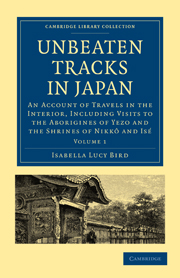 Unbeaten Tracks in Japan
Unbeaten Tracks in Japan Published online by Cambridge University Press: 05 July 2011
By seven the next morning the rice was eaten, the room as bare as if it had never been occupied, the bill of 80 sen paid, the house-master and servants with many sayo naras, or farewells, had prostrated themselves, and we were away in the kurumas at a rapid trot. At the first halt my runner, a kindly, good-natured creature, but absolutely hideous, was seized with pain and vomiting, owing, he said, to drinking the bad water at Kasukabe, and was left behind. He pleased me much by the honest independent way in which he provided a substitute, strictly adhering to his bargain, and never asking for a gratuity on account of his illness. He had been so kind and helpful that I felt quite sad at leaving him there ill,—only a coolie to be, sure, only an atom among the 34,000,000 of the Empire, but not less precious to our Father in heaven than any other. It was a brilliant day, with the mercury 86° in the shade, but the heat was not oppressive. At noon we reached the Toné and I rode on a coolie's tattooed shoulders through the shallow part, and then, with the kurumas, some ill-disposed pack-horses, and a number of travellers, crossed in a flat-bottomed boat. The boatmen, travellers, and cultivators, were nearly or altogether without clothes, but the richer farmers worked in the fields in curved bamboo hats as large as umbrellas, kimonos with large sleeves not girt up, and large fans attached to their girdles. Many of the travellers whom we met were without hats, but shielded the front of the head by holding a fan between it and the sun.
To save this book to your Kindle, first ensure [email protected] is added to your Approved Personal Document E-mail List under your Personal Document Settings on the Manage Your Content and Devices page of your Amazon account. Then enter the ‘name’ part of your Kindle email address below. Find out more about saving to your Kindle.
Note you can select to save to either the @free.kindle.com or @kindle.com variations. ‘@free.kindle.com’ emails are free but can only be saved to your device when it is connected to wi-fi. ‘@kindle.com’ emails can be delivered even when you are not connected to wi-fi, but note that service fees apply.
Find out more about the Kindle Personal Document Service.
To save content items to your account, please confirm that you agree to abide by our usage policies. If this is the first time you use this feature, you will be asked to authorise Cambridge Core to connect with your account. Find out more about saving content to Dropbox.
To save content items to your account, please confirm that you agree to abide by our usage policies. If this is the first time you use this feature, you will be asked to authorise Cambridge Core to connect with your account. Find out more about saving content to Google Drive.